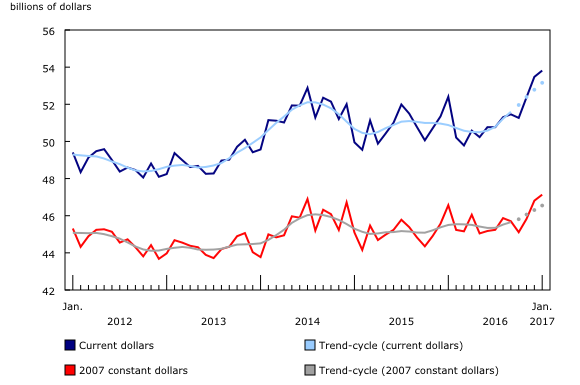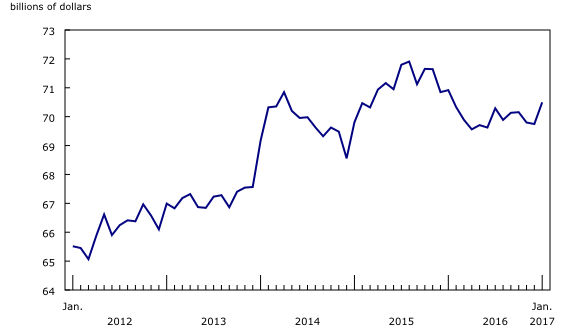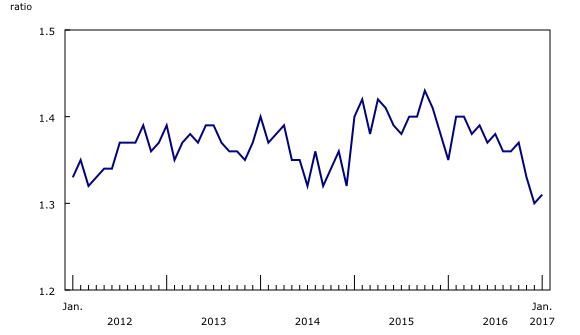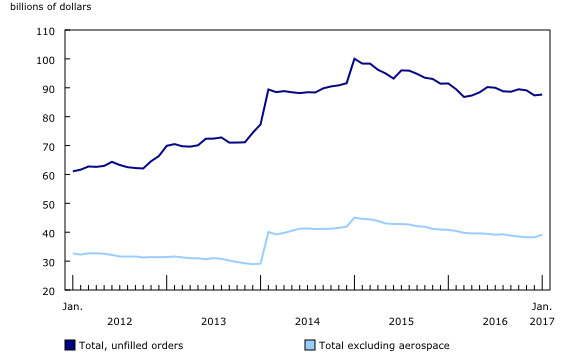Monthly Survey of Manufacturing, January 2017
Archived Content
Information identified as archived is provided for reference, research or recordkeeping purposes. It is not subject to the Government of Canada Web Standards and has not been altered or updated since it was archived. Please "contact us" to request a format other than those available.
Released: 2017-03-17
Manufacturing sales rose for the third consecutive month, up 0.6% to $53.8 billion in January. The gain stemmed from a 2.3% increase in non-durable goods sales, led by the petroleum and coal, and chemical industries.
Sales were up in 14 of 21 industries, representing 75.4% of the total Canadian manufacturing sector.
In constant dollars, sales increased 0.7%, indicating that higher volumes of manufactured goods were sold in January.
Petroleum and coal product sales lead the gains
Sales in the petroleum and coal products industry grew 7.0% to $5.5 billion in January, the fourth consecutive monthly gain. The increase reflected higher prices and volumes for petroleum and coal products. After removing the effect of price changes, sales in volume terms increased 2.1% in January.
Sales in the chemical manufacturing industry rose 2.5% to $4.5 billion, the third increase in four months. A large part of the gain was the result of higher demand by farmers for pesticides and other agricultural chemicals products, which usually occurs before the start of the season.
In constant dollars, sales in the chemical industry were up 2.0%, indicating higher volumes of chemical products were sold.
Sales in current dollars also increased in the fabricated metal product (+2.4%) and the food (+0.7%) industries. These gains were widespread and reflected higher volumes in both industries.
Overall sales in the transportation equipment industry declined 2.9% to $10.9 billion, although sales in the motor vehicle industry increased 3.9% to $6.0 billion in January. This gain was not sufficient to offset decreases in the other transportation equipment (-44.7%) and aerospace product and parts (-11.8%) industries. After removing price effects, volumes sold declined by 43.9% and 8.5% respectively in both industries, following strong volumes in December.
Ontario leads the gains
Sales rose in seven provinces in January, led by Ontario.
Ontario manufacturing sales increased 1.0% to $25.9 billion, the third consecutive monthly advance. Higher sales in the petroleum and coal industry (+10.4%) were responsible for half of the provincial increase. Sales were also up in the food (+2.0%), chemical (+2.2%) and fabricated metal industries (+2.6%). A 4.5% gain in the motor vehicle industry failed to offset the 0.5% decline in the transportation equipment industry.
In Alberta, sales rose 2.7% to $5.7 billion, the third consecutive monthly increase. Gains were recorded in 14 of 21 industries, largely driven by an 8.6% increase in the petroleum and coal products industry and, to lesser extent, from gains in machinery and the chemical industries.
Sales in Quebec fell 1.5% to $12.6 billion, following two consecutive monthly gains. The decline was mostly attributable to lower production in the aerospace product and parts industry. These decreases were partly offset by higher sales in the petroleum and coal, fabricated metal and chemical industries.
Inventory levels increased
Inventory levels rose 1.1% to $70.5 billion in January. Inventories were up in 17 of 21 industries, led by the petroleum and coal product (+5.2%), machinery (+2.5%), primary metal (+1.9%) and food (+1.6%) industries.
The inventory-to-sales ratio increased from 1.30 in December to 1.31 in January. The inventory-to-sales ratio measures the time, in months, that would be required to exhaust inventories if sales were to remain at their current level.
Unfilled orders rise
Unfilled orders increased 0.3% to $87.7 billion in January, following two months of declines. Most of the gain came from a 5.1% increase in the machinery industry. Unfilled orders in the machinery industry reached $7.3 billion in January, their highest level since March 2015. Unfilled orders also rose in the electrical equipment, appliance and component and fabricated metal industries.
New orders rose 4.6% to $54.1 billion in January, following two consecutive monthly declines. The gain mostly reflected an increase in new orders in the aerospace products and parts and motor vehicle industries.

In celebration of the country's 150th birthday, Statistics Canada is presenting snapshots from our rich statistical history.
The evolution of the Canadian manufacturing sector
Gross value of production is a reasonably close approximation for sales of goods manufactured. In 1870, three years into confederation, the gross value of production for petroleum and coal product industry was $4 million. By 1917 it reached $59 million.
Following a major discovery in Alberta in 1947, the focus of the petroleum industry shifted west with significant increases in exploration and production activities, and by the time Canada turned 100 in 1967, sales of goods manufactured for the petroleum and coal product industry were over $1.5 billion.
Spurred by the two oil crises in the 1970's and early 1980's they grew to $24.4 billion. Sales peaked at $85.1 billion in 2012 and have recently fallen to $51.3 billion in 2016 with the drop in oil prices.
Note to readers
Monthly data in this release are seasonally adjusted and are expressed in current dollars unless otherwise specified. For information on seasonal adjustment, see Seasonally adjusted data – Frequently asked questions.
For information on trend-cycle data, see Trend-cycle estimates – Frequently asked questions.
With this release, the Monthly Survey of Manufacturing has published real (price deflated) sales of goods manufactured for the principal manufacturing industries. The industry-level data are now available on CANSIM table 377-0009 for reference months January 2007 to January 2017.
Non-durable goods industries include food, beverage and tobacco products, textile mills, textile product mills, clothing, leather and allied products, paper, printing and related support activities, petroleum and coal products, chemicals, and plastics and rubber products.
Durable goods industries include wood products, non-metallic mineral products, primary metals, fabricated metal products, machinery, computer and electronic products, electrical equipment, appliances and components, transportation equipment, furniture and related products, and miscellaneous manufacturing.
Production-based industries
For the aerospace and shipbuilding industries, the value of production is used instead of the value of sales of goods manufactured. The value of production is calculated by adjusting monthly sales of goods manufactured by the monthly change in inventories of goods in process and finished products manufactured. The value of production is used because of the extended period of time that it normally takes to manufacture products in these industries.
Unfilled orders are a stock of orders that will contribute to future sales assuming that the orders are not cancelled.
New orders are those received, whether sold in the current month or not. New orders are measured as the sum of sales for the current month plus the change in unfilled orders from the previous month to the current month.
Manufacturers reporting in US dollars
Some Canadian manufacturers report sales, inventories and unfilled orders in US dollars. These data are then converted to Canadian dollars as part of the data production cycle.
For sales, based on the assumption that they occur throughout the month, the average monthly exchange rate for the reference month (noon spot rate) established by the Bank of Canada is used for the conversion. The monthly average exchange rate is available in CANSIM table 176-0064.
Inventories and unfilled orders are reported at the end of the reference period. For most respondents, the noon spot exchange rate on the last working day of the month is used for the conversion of these variables. However, some manufacturers choose to report their data as of a day other than the last day of the month. In these instances, the noon spot exchange rate on the day selected by the respondent is used. Note that because of exchange rate fluctuations, the noon spot exchange rate on the day selected by the respondent can differ from both the exchange rate on the last working day of the month and the monthly average exchange rate. Noon spot exchange rate data are available in CANSIM table 176-0067.
Revision policy
Each month, the Monthly Survey of Manufacturing releases preliminary data for the reference month and revised data for the three previous months. Revisions are made to reflect new information provided by respondents and updates to administrative data. Once a year, a revision project is undertaken to revise multiple years of data. During annual revisions, changes are made to seasonal adjustment parameters.
Real-time CANSIM tables
Real-time CANSIM tables 304-8014, 304-8015 and 377-8009 will be updated on March 27. For more information, consult the document Real-time CANSIM tables.
Next release
Data from the Monthly Survey of Manufacturing for February will be released on April 13.
Contact information
For more information, or to enquire about the concepts, methods or data quality of this release, contact us (toll-free 1-800-263-1136; 514-283-8300; STATCAN.infostats-infostats.STATCAN@canada.ca).
To enquire about the concepts, methods or data quality of this release, contact Bechir Oueriemmi (613-951-7938; bechir.oueriemmi@canada.ca) or Michael Schimpf (613-863-4480; michael.schimpf@canada.ca), Manufacturing and Wholesale Trade Division.
- Date modified:






